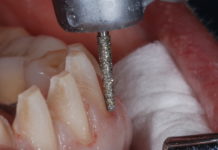
IT’S NOT THE FINISH, BUT THE SETUP THAT COUNTS.
Every successful track athlete knows the importance of a good start. If the starting blocks aren’t setup exactly right, if the feet aren’t placed in the correct position and the knees aren’t bent at the proper angles, the sprinters simply won’t perform to their best ability. The way sprinters prepare for a race is equally as important as anything they do during the actual race.
This metaphor and all its implications can be directly applied to dentists who perform (or want to perform) more advanced procedures in cosmetic dentistry. The start is key. The start is crucial. If you don’t have the correct training—if you don’t choose the right case, properly plan and prepare—you won’t have a positive outcome. That’s a plain and simple truth. The ultimate success or failure of advanced cosmetic cases (such as full arch reconstructions and implants) is directly tied to the way you start.
Starting Block #1: Mentorship
One of the key components, or starting blocks, that is often missing in our profession is quality mentorship. After I graduated from dental school, I bought my first dental practice. Three months later, the dentist I purchased the practice from was gone, leaving me to run the practice solo. Because of that, I honestly struggled during the first few years. My only source of knowledge was what I learned in dental school and frankly, that just wasn’t enough. I didn’t have a seasoned dentist to query when I ran into difficulties. I was completely on my own.
The second practice I purchased was located next to my first one. Fortunately, the situation with this purchase was very different from the previous one. Instead of leaving in three months (like the first dentist), the senior dentist at the second practice stayed on for an additional five years. Those five years proved invaluable to me and my future success as an independent dentist. I learned a tremendous amount from the veteran dentist. Even though he already had his feet on the pathway towards retirement, he continued to look for ways to improve and grow. I found this quite inspiring and I really valued his advice and mentorship.
One of the best pieces of advice I learned during that time was to seek out opportunities for continuing education (CE). I searched out CE courses that allowed me to improve productivity and overall patient care. Fortunately, this senior dentist was already experienced in many of the procedures that I received training on in my CE classes. He was a pioneer in implants (he started doing them in the 1950s) and had also performed many full arch cases as well.
When I returned from the CE courses, I found it extremely helpful to have someone to talk with about my newfound knowledge. I asked my seasoned mentor questions about the things I learned and he was able to give me feedback from his professional experiences. Such conversations were abundantly helpful and served as a guide as I refined my repertoire of skills. My practice really wouldn’t be the practice that it is today without my early relationship with this expert mentor.
For every new dentist—or dentist who is looking at advancing his or her career by learning new procedures—finding the right mentor is extremely critical to your overall success. Mentors can be found in all kinds of places. I have found mentorship from fellow colleagues in my geographical area. I have also found fantastic mentors through friends at CE classes and conferences.
I’m a firm believer, too, in paying it forward. Because so many wonderful people have mentored me over the years, I have also tried to mentor others. For example, dentists who attend my hands-on and over-the-shoulder courses know that if they run into a problem at any time during a procedure, they can simply get on the phone and call me. My front office team knows when they hear the code word, “HELP!” they should notify me immediately and I will talk the dentist through whatever difficulty he or she might be having. Just as contestants on the game show, “Who Wants to Be A Millionaire?” can phone a friend or other ‘lifeline’ when faced with a challenging question, every dentist needs a trusted mentor they can call on for help and advice. Find one or be one. That’s a key starting block for success in cosmetic dentistry.
Starting Block #2: Proper Training
As with anything in life, if you want to do something, you first have to know how to do it! While that might seem totally obvious, it’s a key principle that people often forget. While what we learn in dental school is essential, it certainly isn’t enough to enable dentists to perform the advanced cosmetic procedures that can truly benefit their patients and their practice. Proper training from CE courses is a key starting block, especially in over-the-shoulder and hands-on instruction.
Not only do dentists need proper training, but so do their teams. Remember that oft-quoted mantra, “There is no ‘I’ in team?” Well, that statement is especially true when it comes to training your office staff on advanced cosmetic procedures. Don’t just sign up for one CE course after another without including your team in that training. The best way to involve your team in something like a full arch course, for example, is to sign up for the first course yourself, so that you can get a general overview of the techniques. Then, for the next course in the series, bring along members of your team. I have found that dentists who bring their teams to CE proceed further and faster with advanced procedures than those dentists who attend the classes alone.
When you bring members of your team, everyone has a common experience that you can discuss with each other when you’re back at the daily grind in the office. Everyone has the same knowledge base and understanding of specific terminology and procedures. This simply can’t be duplicated in any other way—it must be experienced and learned together in a formal course. I have noticed that when members of a dentist’s team attend the trainings with the dentist, they often take on a new demeanor by the end of the course. They suddenly have a newfound excitement for the practice and their jobs. They have witnessed with their own eyes what dentistry can truly offer. They suddenly have an overwhelming feeling of, “Wow! We can really do this for our patients!” If you want your team members to swiftly have a huge amount of professional respect for you and what you do, bring them with you to the CE courses! They will see life-changing dentistry, not just the menial tasks that may be commonplace in the office. Your team members will become raving fans and will pass on this excitement to your patients. They truly will become your best advertisements and cheerleaders!
Not only is formal CE training necessary, but so is the less formal training that you conduct in your office. One of the methods of ongoing training that is very helpful is to make “Setup Books.” In my practice, these books contain the step-by-step instructions of how to setup and complete the procedures. They include both detailed instructions and photographs. These setup books have proven very helpful for the team, as they review them often to remember the various crucial steps and their own responsibilities.
Setup books are also helpful when new team members are hired—which, if your practice is like the bulk of dental offices out there—will likely be often. In reality, the only person who will stay with the practice for the long haul until you retire is you. Members of your team will come and go over the years and with that fluctuation comes a need for consistent training. Setup books can be adapted and updated easily. Just keep an electronic copy on the hard drive of the front office computer in a word processing program (such as Microsoft Word) and simply update as needed by adjusting the text or photos and reprinting.
Starting Block #3: Case Selection
One of my mentors, Dr. Dick Barnes, is often asked which comes first, confidence or success. His answer is always the same: success comes first. I totally agree.
With that idea in mind, it’s abundantly clear why proper case selection is so crucial for dentists. If a dentist chooses a case that is out of his or her range of expertise, then that dentist likely will not have much success at completion. Then, because of that unsuccessful experience, the dentist will have less confidence in his or her abilities to do a related case in the future and may—unfortunately—avoid such types of procedures altogether. This is especially true with advanced procedures in cosmetic dentistry, such as full arch cases and implants. These are difficult procedures that require technical knowledge and skill and, more importantly, the correct case at the outset.
In my courses, I often refer to an idea called, “Taming the Gremlin.” A gremlin represents a person’s internal doubts and fears. The most effective way to tame your gremlin is to utilize an early-win strategy. Get a first successful case under your belt. That will help you build confidence and create a point of reference that you and your team can build upon.
So how do new dentists choose the proper first case? Here are some of my personal tips:
Dr. Down’s Full Arch Case Tips for Beginners:
• Choose an asymptomatic case on the upper arch that is being done for mostly aesthetic reasons.
• Avoid cases that involve verticalizing.
• Avoid cases where patients have extreme wear on their teeth and cases that require splint therapy.
Dr. Down’s Implant Case Tips for Beginners:
• Start with a single first bicuspid in the upper arch or a first molar in the upper or lower arch.
• Avoid cases where the teeth are drifting together.
• Avoid cases where there is insufficient bone.
• Avoid cases where you will be working really close to the sinus.
Starting Block #4: The Setup
The setup for any dental procedure is extremely important. There are specific processes that each dentist should follow every time he or she prepares a case, so when ‘race time’ arrives, you’re ready to run. There are also specific protocols that staff members should follow so the entire office is ready and at the starting block when the patient arrives.
Pre-Visualization and the Bailout Plan
Before completing any procedure, I always take time to review all of the specifics about the case and pre-visualize each step that I will complete. This pre-visualization process is extremely important in achieving a successful outcome. I implemented this technique with my first cosmetic procedure and I continue to do so today, even though I’ve completed hundreds of them. Think about it—it really doesn’t matter how many times a sprinter runs a race or a distance runner completes a marathon, he or she still has to properly prepare every time to do their best.
When I pre-visualize, I imagine all of the different scenarios I may encounter during the procedure and how I can successfully handle emergency situations. I always strategize a bailout plan, so if I encounter problems, I can handle them without any stress. Having a strong ‘plan B’ solidified is essential. If a situation turns out differently than anticipated, you can handle it and move forward in a positive direction. You won’t panic and do something unwise just because you’re confronted with the unexpected.
This pre-visualization technique also helps me during the analysis stage of case selection. For example, suppose I pre-visualize a case and contemplate any potential complications. If I envision a scenario that I suddenly feel fear at being able to manage properly, I then consider if I feel fear because I’m just nervous or if I feel fear because I honestly don’t have the skills to handle the situation. If my answer is the latter, then I need to get those skills before I can tackle that particular case.
The information in the pre-visualization stage is also helpful when I consult with my patients. In this discussion, I tell them about the different possible scenarios and my plans for any contingencies. If everything goes ideally, I continue with plan A and the patient will have the full arch or implant as we have discussed. If, however, during the procedure I discover that there is less bone than I anticipated or another unfavorable situation presents itself, then I might resort to plan B (stitch the patient up and reschedule another visit to complete the full arch or implant). By being upfront with the patient in this manner, I don’t worry that the patient may be upset if plan A isn’t achieved. As a dentist, this takes some pressure off. It allows me to calmly work through the procedure and make the best possible decisions, regardless of the circumstances.
Completing a Dry Run
Runners don’t step out onto a track for the first time on the day of the race. And when it comes to performing advanced cosmetic procedures, neither should you! You shouldn’t go through the motions of a procedure for the first time when the patient is sitting sedated in your chair! Dry runs—or rehearsals of a performance or procedure—are essential for a successful outcome.
To complete a dry run in my practice, we run through every single step of the process, from the setup of the room and prepping the patient, to the actual clinical procedure. During this ‘dress rehearsal,’ we perform everything exactly like the plan for the actual game day. This gives staff members an opportunity to ask questions and get answers. It gives me a chance to provide specific tips and directions to improve the flow of the process.
In my courses, I provide a specific checklist for dentists and their teams to follow for advanced procedures. Following a checklist during a dry run and the actual procedure helps bring consistency and predictability to all of your cases. (click here for Dr. Downs Full Mouth Prep and Seat lists)
Of course, dry runs don’t have to be completed before every case, especially if you eventually do these procedures on a consistent basis. However, if you don’t complete these types of advanced cases very often, then it’s a good idea to implement the dry runs as needed. A few minutes spent in running through this rehearsal may save you a lot of grief later on. By doing them, everyone on your team will feel more confident and comfortable and will thereby ensure a greater outcome for the procedure.
The Finish Line
Once you have completed an advanced cosmetic case, take some time to celebrate the success with your team. In my office, we start each week by discussing our wins from the previous week. What kinds of things did we do well in each of our cases? What specific wins did team members notice about the case and each other?
Taking time to appreciate your team and reflect on your accomplishments and successes gives everyone improved confidence. This confidence drives the momentum in your office, which will ultimately lead to even more success and then even more confidence!
As Dr. Dick Barnes says, success comes first and then confidence. Cheering each other along as you cross the finish line is a great way to provide each member of your team with a great amount of both! From the starting blocks to the finish line, your team will rise to their full potential and help you build a practice that offers tremendous benefits to you and your patients.
CLICK HERE for Dr. Downs Full Mouth Prep and Seat lists and get your self prepared for your next advanced procedure.










